Laxative Effects of a Standardized Extract of Dendropanax morbiferus H. Léveille Leaves on Experimental Constipation in Rats
Abstract
:1. Introduction
2. Materials and Methods
2.1. Reagents
2.2. Preparation of Extracts
2.3. Solvent-Solvent Fractionation and HPLC Analysis of Extracts
2.4. Cell Culture and Prostaglandin E2 (PGE2) Content Measurement
2.5. Animals and Grouping
2.6. Induction of Low-Fiber Diet-Induced Constipation
2.7. Induction of Loperamide-Induced Constipation
2.8. Measurement of Fecal Parameters
2.9. Gastrointestinal (GI) Motility Test
2.10. Measurement of PGE2 Level in Colons
2.11. Ex Vivo Measurement of Contractile Activity in Isolated Segments of Rat Colon
2.12. Statistical Analysis
3. Results
3.1. HPLC Analysis of DPL
3.2. Effect of DPL Administration on Feeding Behavior in Rats with Low-Fiber Diet-Induced Constipation
3.3. Preventive Effects of DPL Pretreatment on Low-Fiber Diet-Induced Constipation
3.4. The Laxative Effect of DPL on Rats with Low-Fiber Diet-Induced Constipation
3.5. The Effect of DPL on Charcoal Meal Gastrointestinal (GI) Motility in Rats with Low-Fiber Diet-Induced Constipation
3.6. Effect of DPL Administration on Feeding Behavior in Rats with Loperamide-Induced Constipation
3.7. Preventive Effects of DPL Pretreatment on Loperamide-Induced Constipation
3.8. The Laxative Effects of DPL on Rats with Loperamide-Induced Constipation
3.9. The Effect of DPL on Charcoal Meal Gastrointestinal (GI) Motility in Rats with Loperamide-Induced Constipation
3.10. The Effects of DPL on the PGE2 Concentration in RAW264.7 Cells
3.11. The Effects of DPL on the PGE2 Concentration in the Colons of Rats with Loperamide-Induced Constipation
3.12. The Effects of DPL on Colon Contraction
3.13. The Effects of DPL Fractions on Spontaneous Colon Contraction
4. Discussion
5. Conclusions
Supplementary Materials
Author Contributions
Funding
Institutional Review Board Statement
Data Availability Statement
Conflicts of Interest
References
- Longstreth, G.F.; Thompson, W.G.; Chey, W.D.; Houghton, L.A.; Mearin, F.; Spiller, R.C. Functional bowel disorders. Gastroenterology 2006, 130, 1480–1491. [Google Scholar] [CrossRef]
- Mostafa, R. Rome III: The functional gastrointestinal disorders, third edition, 2006. World J. Gastroenterol. 2008, 14, 2124–2215. [Google Scholar] [CrossRef]
- Johnson, D.A. Treating chronic constipation: How should we interpret the recommendations? Clin. Drug Investig. 2006, 26, 547–557. [Google Scholar] [CrossRef]
- Lembo, A.; Camilleri, M. Chronic constipation. N. Engl. J. Med. 2003, 349, 1360–1368. [Google Scholar] [CrossRef] [PubMed]
- Busti, A.J.; Murillo, J.R., Jr.; Cryer, B. Tegaserod-induced myocardial infarction: Case report and hypothesis. Pharmacotherapy 2004, 24, 526–531. [Google Scholar] [CrossRef] [PubMed]
- Kim, J.E.; Lee, Y.J.; Kwak, M.H.; Ko, J.; Hong, J.T.; Hwang, D.Y. Aqueous extracts of Liriope platyphylla induced significant laxative effects on loperamide-induced constipation of SD rats. BMC Complement Altern Med. 2013, 13, 333. [Google Scholar] [CrossRef] [PubMed] [Green Version]
- Bae, K. The Medicinal Plants of Korea; Kyo-Hak Publishing: Seoul, Korea, 2000. [Google Scholar]
- Hyun, T.K.; Kim, M.O.; Lee, H.; Kim, Y.; Kim, E.; Kim, J.S. Evaluation of anti-oxidant and anti-cancer properties of Dendropanax morbifera Léveille. Food Chem. 2013, 141, 1947–1955. [Google Scholar] [CrossRef]
- Moon, H.I. Antidiabetic effects of dendropanoxide from leaves of Dendropanax morbifera Leveille in normal and streptozotocin-induced diabetic rats. Hum. Exp. Toxicol. 2011, 30, 870–875. [Google Scholar] [CrossRef]
- Chung, I.M.; Kim, M.Y.; Park, W.H.; Moon, H.I. Antiatherogenic activity of Dendropanax morbifera essential oil in rats. Pharmazie 2009, 64, 547–549. [Google Scholar]
- Lee, K.H.; Na, H.J.; Song, C.K.; Kang, S.Y.; Kim, S. Quercetin quantification in a Jeju Dendropanax morbifera Lev. extract by varying different parts, harvest times, and extraction solvents. Korean J. Food Preserv. 2018, 25, 344–350. [Google Scholar] [CrossRef]
- Myoung, H.Y.; Shakina, Y.S.; Ahn, S.; Verónica, C.A.; Wang, C.; Mathiyalagan, R.; Hurh, J.; Batjikh, I.; Ali, H.; Kim, Y.J.; et al. Anti-obesity effect of gold nanoparticles from Dendropanax morbifera Léveille by suppression of triglyceride synthesis and downregulation of PPARγ and CEBPα signaling pathways in 3T3-L1 mature adipocytes and HepG2 Cells. Curr. Nanosci. 2020, 16, 198–203. [Google Scholar] [CrossRef]
- Park, S.; Lee, K.H.; Kang, W.S.; Kim, J.S.; Kim, S. Endothelium-dependent and endothelium-independent vasorelaxant effects of unripe Rubus coreanus Miq. and Dendropanax morbiferus H. Lév. extracts on rat aortic rings. BMC Complement Med. Ther. 2020, 20, 190. [Google Scholar] [CrossRef]
- Shen, L.; Gwak, S.R.; Joo, J.C.; Ha, K.C.; Park, Y.K.; Kim, S.; Park, S.J. Effectiveness and Safety of Hwangchil-Unripe Bokbunja Extract Mixture on Blood Pressure: A Randomized Double-Blind Placebo-Controlled Clinical Trial. J. Med. Food. 2021, 24, 258–266. [Google Scholar] [CrossRef] [PubMed]
- Lee, K.H.; Kim, S. Optimal enzymatic hydrolysis conditions for increased production of L-arginine and GABA in Dendropanax morbifera Lev. Leaves. Korean J. Food Preserv. 2019, 26, 289–299. [Google Scholar] [CrossRef]
- The European Parliament and the Council of the European Union. Directive 2010/63/EU of the European Parliament and of the Council of 22 September 2010 on the Protection of Animals Used for Scientific Purposes. Off. J. Eur. Union 2010, 276, 33–79. Available online: https://eur-lex.europa.eu/LexUriServ/LexUriServ.do?uri=OJ:L:2010:276:0033:0079:EN:PDF (accessed on 9 July 2020).
- Kakino, M.; Tazawa, S.; Maruyama, H.; Tsuruma, K.; Araki, Y.; Shimazawa, M.; Hara, H. Laxative effects of agarwood on low-fiber diet-induced constipation in rats. BMC Complement Altern Med. 2010, 10, 68. [Google Scholar] [CrossRef] [Green Version]
- Na, J.R.; Oh, K.N.; Park, S.U.; Bae, D.; Choi, E.J.; Jung, M.A.; Choi, C.Y.; Lee, D.W.; Jun, W.; Lee, K.Y.; et al. The laxative effects of Maesil (Prunus mume Siebold & Zucc.) on constipation induced by a low-fibre diet in a rat model. Int. J. Food Sci. Nutr. 2013, 64, 333–345. [Google Scholar] [CrossRef]
- Wintola, O.A.; Sunmonu, T.O.; Afolayan, A.J. The effect of Aloe ferox Mill. in the treatment of loperamide-induced constipation in Wistar rats. BMC Gastroenterol. 2010, 10, 95. [Google Scholar] [CrossRef] [Green Version]
- Lee, H.Y.; Kim, J.H.; Jeung, H.W.; Lee, C.U.; Kim, D.S.; Li, B.; Lee, G.H.; Sung, M.S.; Ha, K.C.; Back, H.I.; et al. Effects of Ficus carica paste on loperamide-induced constipation in rats. Food Chem. Toxicol. 2012, 50, 895–902. [Google Scholar] [CrossRef]
- Méité, S.; Bahi, C.; Yéo, D.; Datté, J.Y.; Djaman, J.A.; N’guessan, D.J. Laxative activities of Mareya micrantha (Benth.) Müll. Arg. (Euphorbiaceae) leaf aqueous extract in rats. BMC Complement Altern Med. 2010, 10, 7. [Google Scholar] [CrossRef] [Green Version]
- Yang, Z.H.; Yu, H.J.; Pan, A.; Du, J.Y.; Ruan, Y.C.; Ko, W.H.; Chan, H.C.; Zhou, W.L. Cellular mechanisms underlying the laxative effect of flavonol naringenin on rat constipation model. PLoS ONE 2008, 3, e3348. [Google Scholar] [CrossRef] [Green Version]
- Bustos, D.; Ogawa, K.; Pons, S.; Soriano, E.; Bandi, J.C.; Bustos Fernández, L. Effect of loperamide and bisacodyl on intestinal transit time, fecal weight and short chain fatty acid excretion in the rat. Acta Gastroenterol. Latinoam. 1991, 21, 3–9. [Google Scholar]
- Ikarashi, N.; Baba, K.; Ushiki, T.; Kon, R.; Mimura, A.; Toda, T.; Ishii, M.; Ochiai, W.; Sugiyama, K. The laxative effect of bisacodyl is attributable to decreased aquaporin-3 expression in the colon induced by increased PGE2 secretion from macrophages. Am. J Physiol. Gastrointest. Liver Physiol. 2011, 301, G887–G895. [Google Scholar] [CrossRef]
- Lim, J.M.; Kim, Y.D.; Song, C.H.; Park, S.J.; Park, D.C.; Cho, H.R.; Jung, G.W.; Bashir, K.M.I.; Ku, S.K.; Choi, J.S. Laxative effects of triple fermented barley extracts (FBe) on loperamide (LP)-induced constipation in rats. BMC Complement Altern Med. 2019, 19, 143. [Google Scholar] [CrossRef]
- Saito, T.; Mizutani, F.; Iwanaga, Y.; Morikawa, K.; Kato, H. Laxative and anti-diarrheal activity of polycarbophil in mice and rats. Jpn. J. Pharmacol. 2002, 89, 133–141. [Google Scholar] [CrossRef] [Green Version]
- Schemann, M. Control of gastrointestinal motility by the “gut brain”-the enteric nervous system. J. Pediatr. Gastroenterol. Nutr. 2005, 41, S4–S6. [Google Scholar] [CrossRef]
- Leng-Peschlow, E. Effects of sennosides A + B and bisacodyl on rat large intestine. Pharmacology 1989, 38, 310–318. [Google Scholar] [CrossRef] [PubMed]
- Marr, N.; Bichet, D.G.; Hoefs, S.; Savelkoul, P.J.; Konings, I.B.; De Mattia, F.; Graat, M.P.; Arthus, M.F.; Lonergan, M.; Fujiwara, T.M.; et al. Cell-biologic and functional analyses of five new Aquaporin-2 missense mutations that cause recessive nephrogenic diabetes insipidus. J. Am. Soc. Nephrol. 2002, 13, 2267–2277. [Google Scholar] [CrossRef] [PubMed] [Green Version]
- Verkman, A.S.; Weyer, P.; Brown, D.; Ausiello, D.A. Functional water channels are present in clathrin-coated vesicles from bovine kidney but not from brain. J. Biol. Chem. 1989, 264, 20608–206013. [Google Scholar] [CrossRef]
- Beubler, E.; Kollar, G.; Saria, A.; Bukhave, K.; Rask-Madsen, J. Involvement of 5-hydroxytryptamine, prostaglandin E2, and cyclic adenosine monophosphate in cholera toxin-induced fluid secretion in the small intestine of the rat in vivo. Gastroenterology 1989, 96, 368–376. [Google Scholar] [CrossRef]
- Resta-Lenert, S.; Barrett, K.E. Enteroinvasive bacteria alter barrier and transport properties of human intestinal epithelium: Role of iNOS and COX-2. Gastroenterology 2002, 122, 1070–1087. [Google Scholar] [CrossRef]
- Cong, P.; Pricolo, V.; Biancani, P.; Behar, J. Abnormalities of prostaglandins and cyclooxygenase enzymes in female patients with slow-transit constipation. Gastroenterology 2007, 133, 445–453. [Google Scholar] [CrossRef]
- Haskó, G.; Szabó, C.; Németh, Z.H.; Kvetan, V.; Pastores, S.M.; Vizi, E.S. Adenosine receptor agonists differentially regulate IL-10, TNF-α, and nitric oxide production in RAW 264.7 macrophages and in endotoxemic mice. J. Immunol. 1996, 157, 4634–4640. [Google Scholar]
- Lee, J.Y.; Cho, B.J.; Park, T.W.; Park, B.E.; Kim, S.J.; Sim, S.S.; Kim, C.J. Dibenzylbutyrolactone lignans from Forsythia koreana fruits attenuate lipopolysaccharide-induced inducible nitric oxide synthetase and cyclooxygenase-2 expressions through activation of nuclear factor-κb and mitogen-activated protein kinase in RAW264.7 cells. Biol. Pharm. Bull. 2010, 33, 1847–1853. [Google Scholar] [CrossRef] [Green Version]
- Boudreau, A.; Poulev, A.; Ribnicky, D.M.; Raskin, I.; Rathinasabapathy, T.; Richard, A.J.; Stephens, J.M. Distinct Fractions of an Artemisia scoparia Extract Contain Compounds With Novel Adipogenic Bioactivity. Front Nutr. 2019, 6, 18. [Google Scholar] [CrossRef]
- Kakino, M.; Izuta, H.; Tsuruma, K.; Araki, Y.; Shimazawa, M.; Ichihara, K.; Hara, H. Laxative effects and mechanism of action of Brazilian green propolis. BMC Complement Altern Med. 2012, 12, 192. [Google Scholar] [CrossRef] [PubMed] [Green Version]
- Kim, J.E.; Lee, M.R.; Park, J.J.; Choi, J.Y.; Song, B.R.; Son, H.J.; Choi, Y.W.; Kim, K.M.; Hong, J.T.; Hwang, D.Y. Quercetin promotes gastrointestinal motility and mucin secretion in loperamide-induced constipation of SD rats through regulation of the mAChRs downstream signal. Pharm. Biol. 2018, 56, 309–317. [Google Scholar] [CrossRef] [Green Version]
- Sathyanathan, V.; Satish, G.; Eswar Kumar, A.; Shuchrajit, M.; Thilothama, L.R. Pharmacological evaluation of laxative effect of Ageratum conyzoides L. on experimental albino rats. Int. J. Res. Pharmacol. Pharmacother. 2013, 2, 274–277. [Google Scholar]
- Seo, J.Y.; Kim, S.S.; Kim, H.J.; Liu, K.H.; Lee, H.Y.; Kim, J.S. Laxative effect of peanut sprout extract. Nutr. Res. Pract. 2013, 7, 262–266. [Google Scholar] [CrossRef] [PubMed]
- Upadhyay, R.; Mohan Rao, L.J. An outlook on chlorogenic acids-occurrence, chemistry, technology, and biological activities. Crit. Rev. Food Sci. Nutr. 2013, 53, 968–984. [Google Scholar] [CrossRef]
- Zhao, X.L.; Yu, L.; Zhang, S.D.; Ping, K.; Ni, H.Y.; Qin, X.Y.; Zhao, C.J.; Wang, W.; Efferth, T.; Fu, Y.J. Cryptochlorogenic acid attenuates LPS-induced inflammatory response and oxidative stress via upregulation of the Nrf2/HO-1 signaling pathway in RAW 264.7 macrophages. Int. Immunopharmacol. 2020, 83, 106436. [Google Scholar] [CrossRef]
- Che, J.; Zhao, T.; Liu, W.; Chen, S.; Yang, G.; Li, X.; Liu, D. Neochlorogenic acid enhances the antitumor effects of pingyangmycin via regulating TOP2A. Mol. Med. Rep. 2021, 23, 158. [Google Scholar] [CrossRef]
- Navarro-Orcajada, S.; Matencio, A.; Vicente-Herrero, C.; García-Carmona, F.; López-Nicolás, J.M. Study of the fluorescence and interaction between cyclodextrins and neochlorogenic acid, in comparison with chlorogenic acid. Sci. Rep. 2021, 11, 3275. [Google Scholar] [CrossRef]
- Park, S.J.; Kim, D.W.; Lim, S.R.; Sung, J.; Kim, T.H.; Min, I.S.; Choi, C.H.; Lee, S.J. Kaempferol Blocks the Skin Fibroblastic Interleukin 1β Expression and Cytotoxicity Induced by 12-O-tetradecanoylphorbol-13-acetate by Suppressing c-Jun N-terminal Kinase. Nutrients 2021, 13, 3079. [Google Scholar] [CrossRef]
- Imran, M.; Salehi, B.; Sharifi-Rad, J.; Aslam Gondal, T.; Saeed, F.; Imran, A.; Shahbaz, M.; Tsouh Fokou, P.V.; Umair Arshad, M.; Khan, H.; et al. Kaempferol: A Key Emphasis to Its Anticancer Potential. Molecules 2019, 24, 2277. [Google Scholar] [CrossRef] [Green Version]
- Leung, L.; Riutta, T.; Kotecha, J.; Rosser, W. Chronic constipation: An evidence-based review. J. Am. Board Fam. Med. 2011, 24, 436–451. [Google Scholar] [CrossRef] [PubMed]
- Gilani, A.H.; Bashir, S.; Janbaz, K.H.; Shah, A.J. Presence of cholinergic and calcium channel blocking activities explains the traditional use of Hibiscus rosasinensis in constipation and diarrhoea. J. Ethnopharmacol. 2005, 10, 289–294. [Google Scholar] [CrossRef] [PubMed]
- Borrelli, F.; Borbone, N.; Capasso, R.; Montesano, D.; De Marino, S.; Aviello, G.; Aprea, G.; Masone, S.; Izzo, A.A. Potent relaxant effect of a Celastrus paniculatus extract in the rat and human ileum. J. Ethnopharmacol. 2009, 122, 434–438. [Google Scholar] [CrossRef] [PubMed]
- Yun, J.W.; Kim, S.H.; Kim, Y.S.; Choi, E.J.; You, J.R.; Cho, E.Y.; Yoon, J.H.; Kwon, E.; Kim, H.C.; Jang, J.J.; et al. Preclinical study of safety of Dendropanax morbifera Leveille leaf extract: General and genetic toxicology. J. Ethnopharmacol. 2019, 238, 111874. [Google Scholar] [CrossRef]
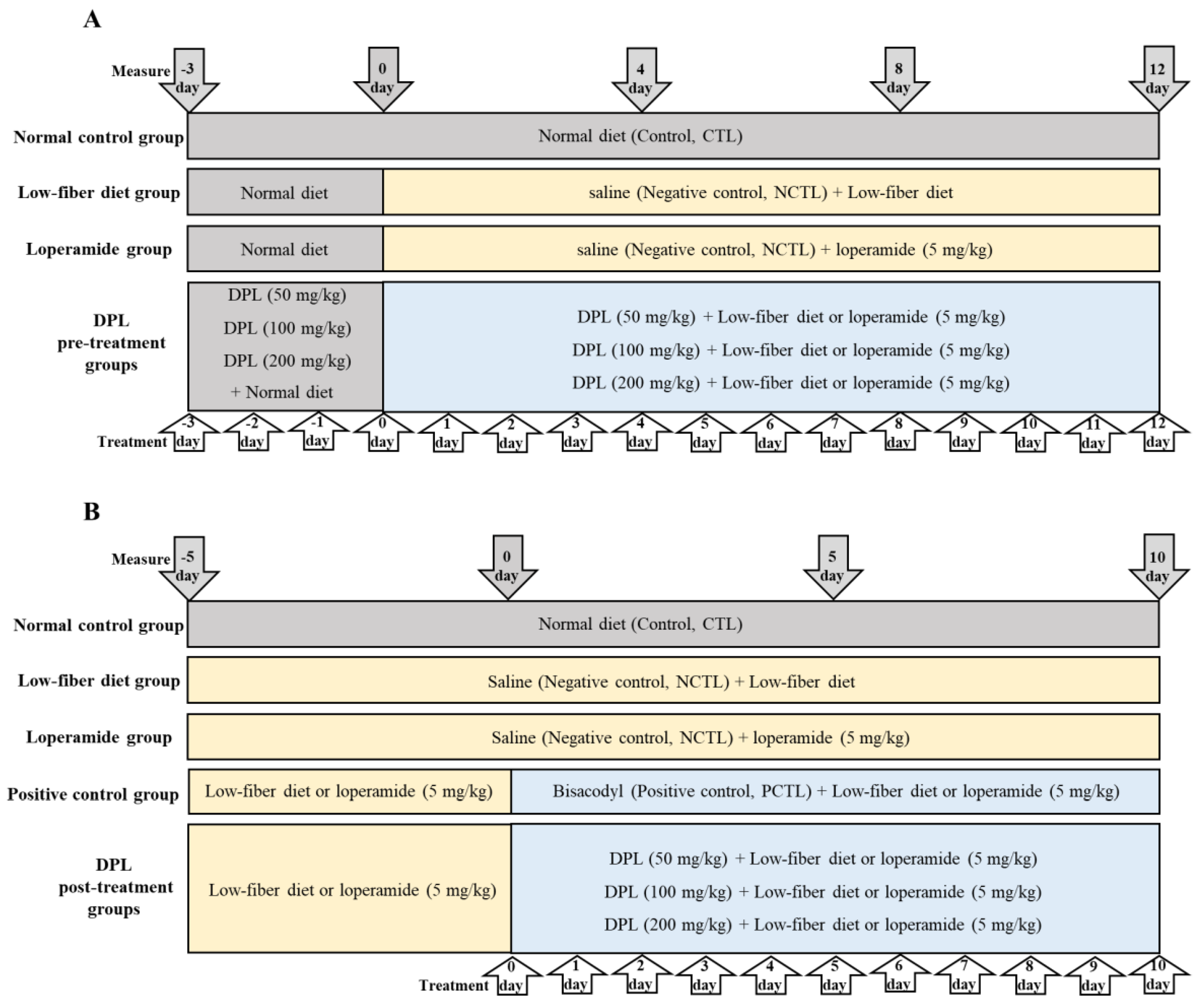

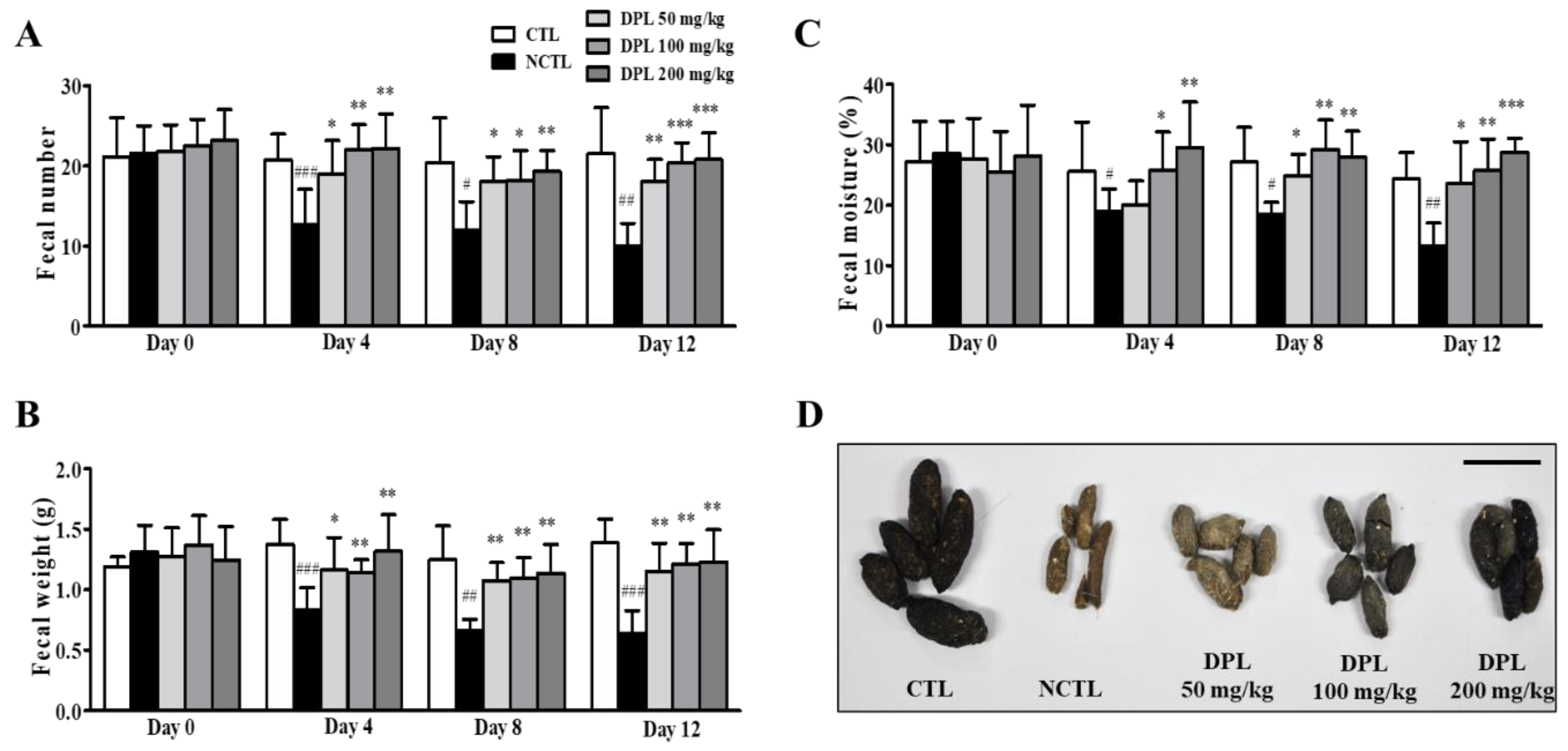

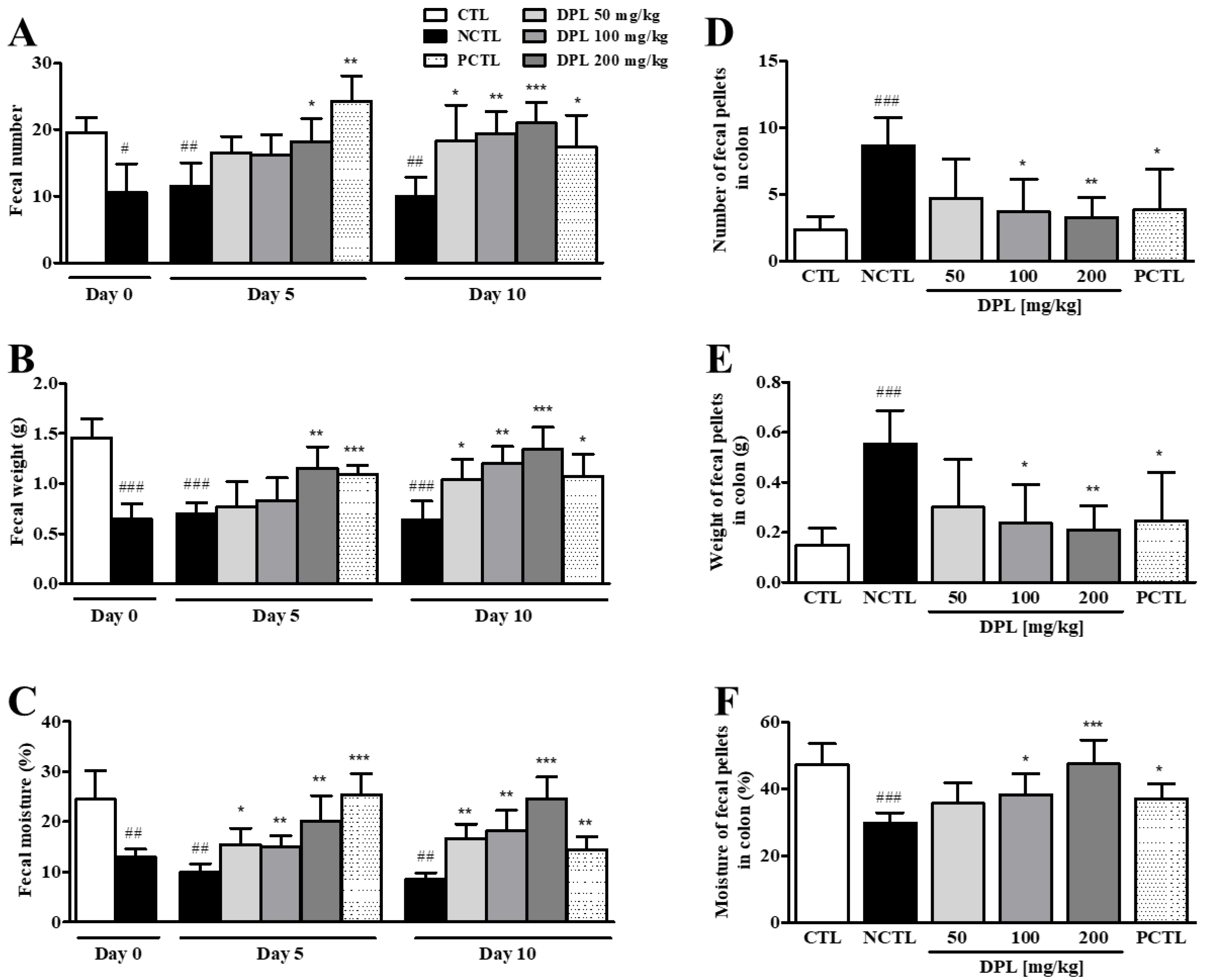
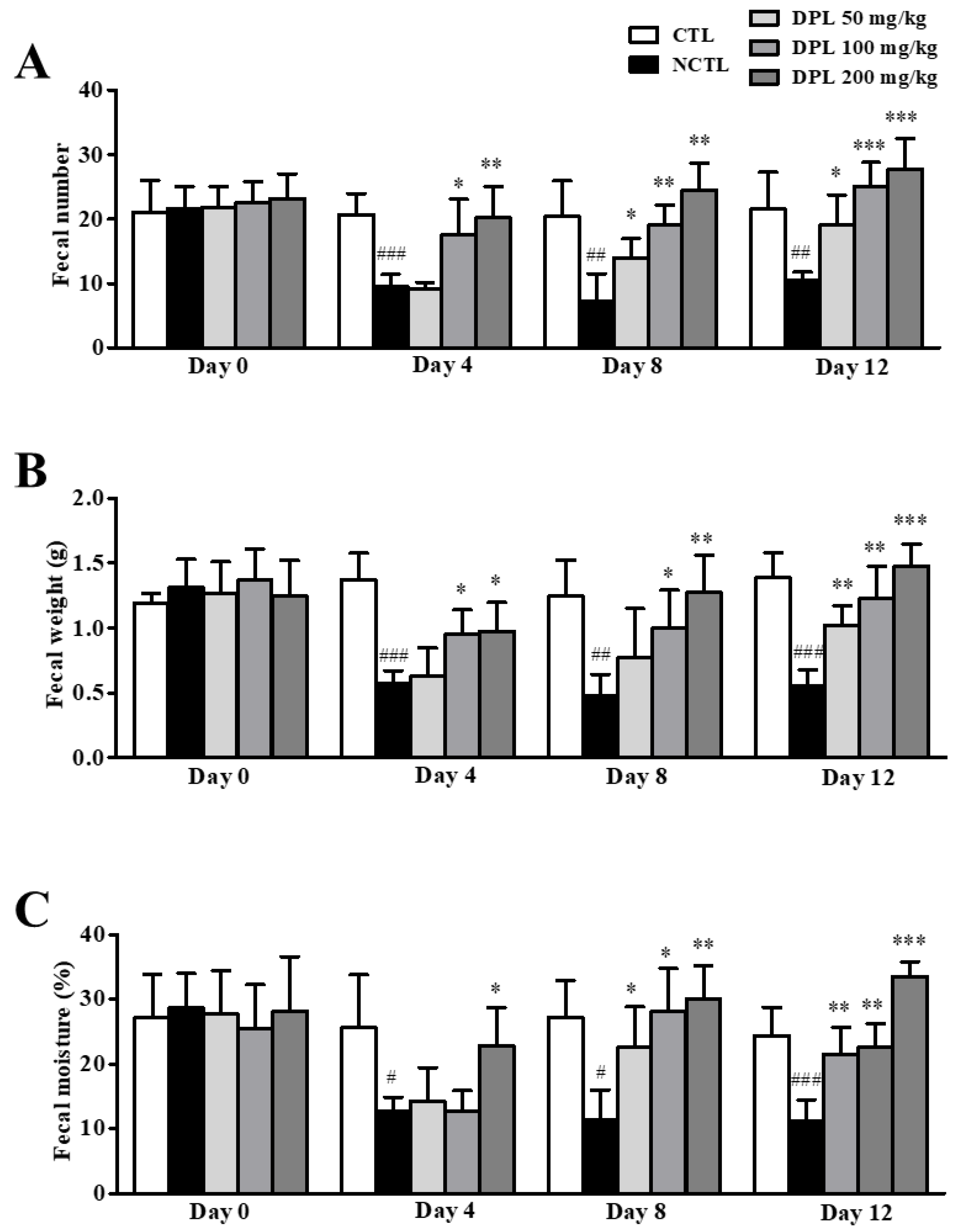
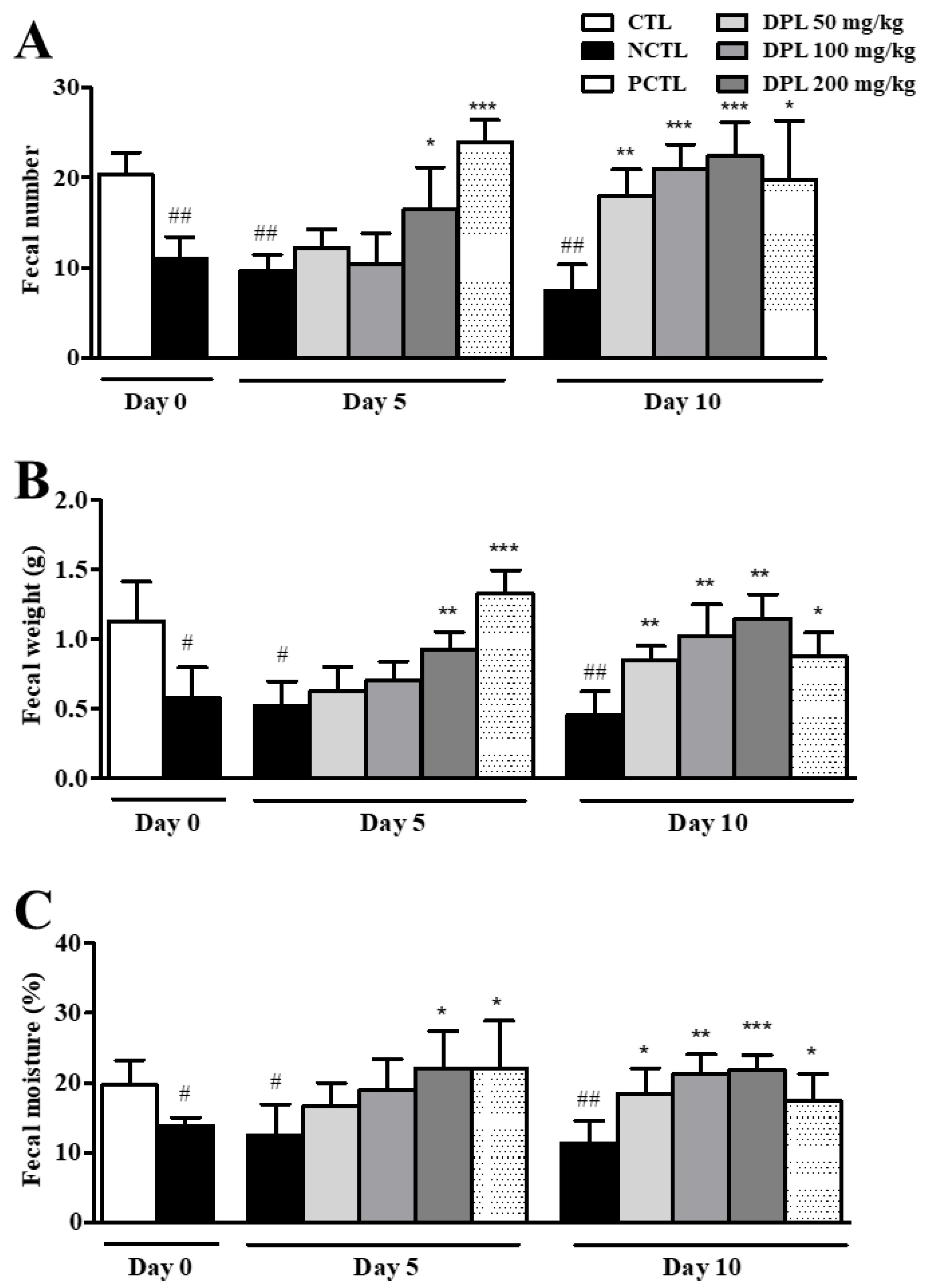
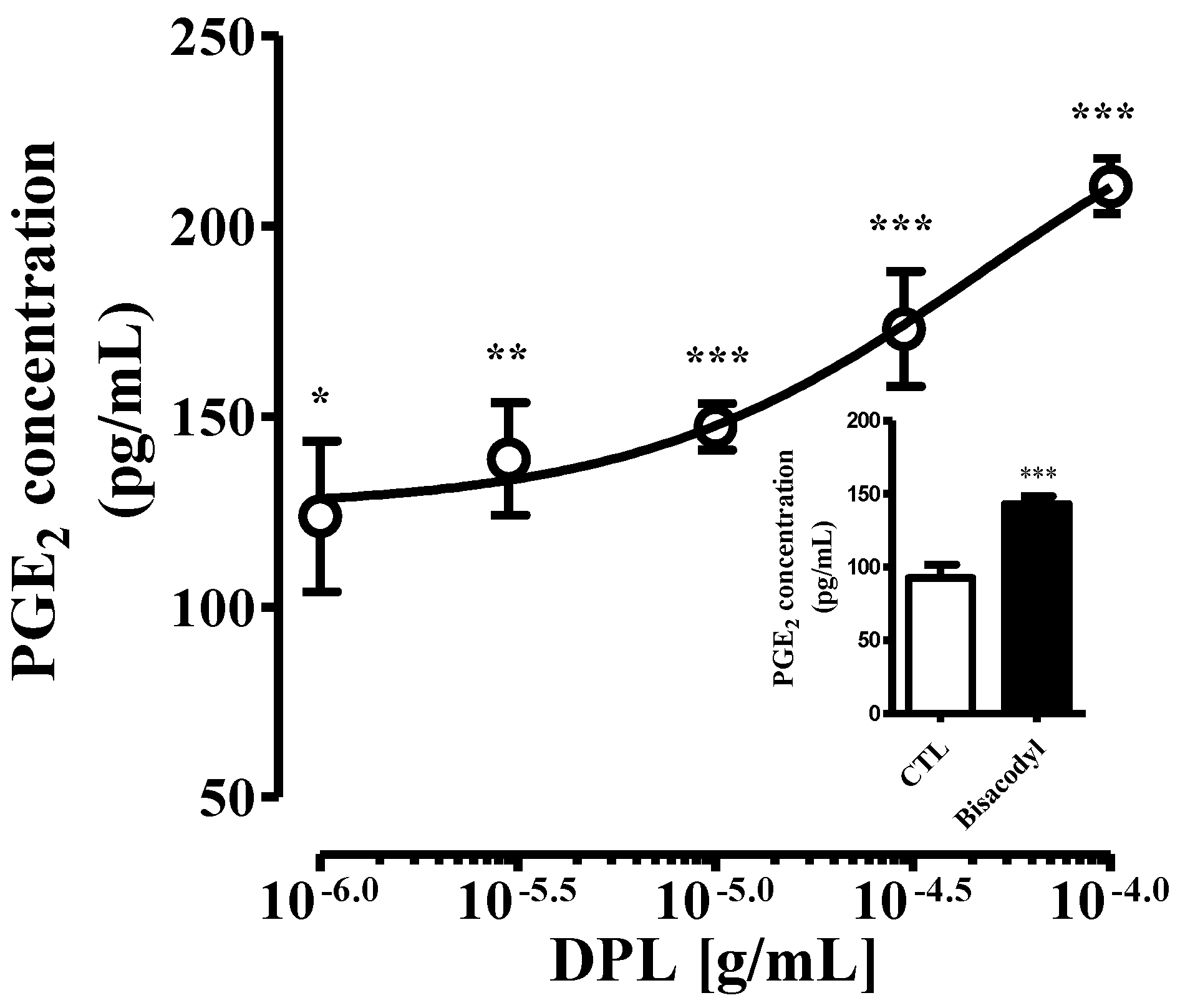
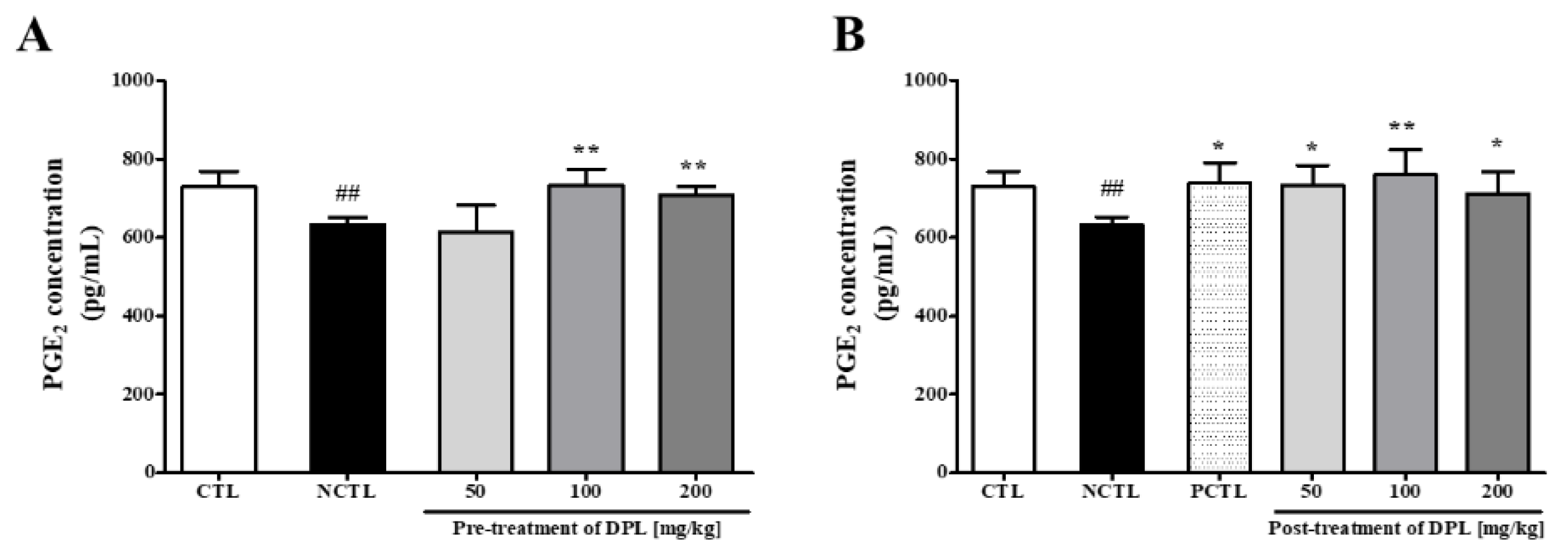
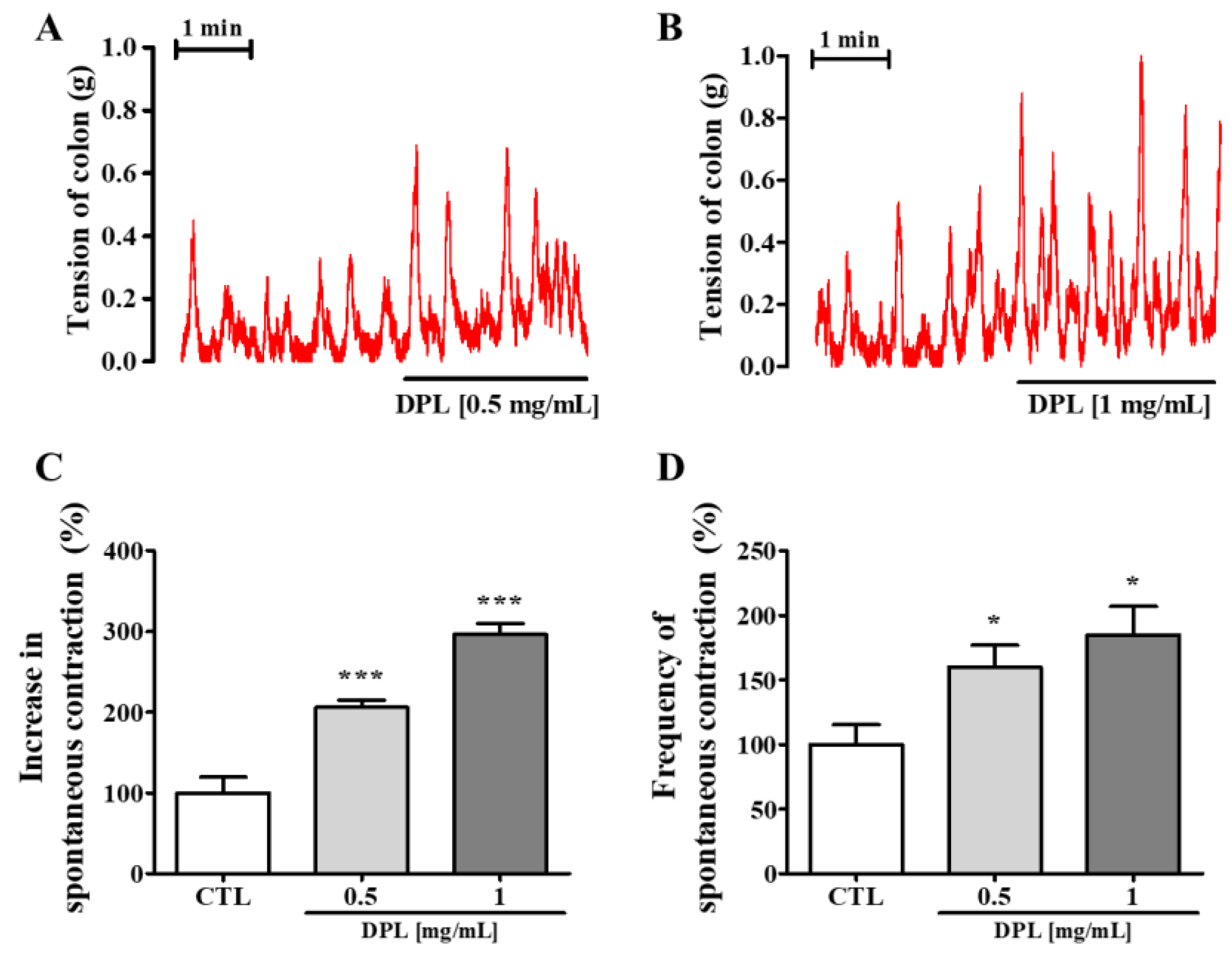
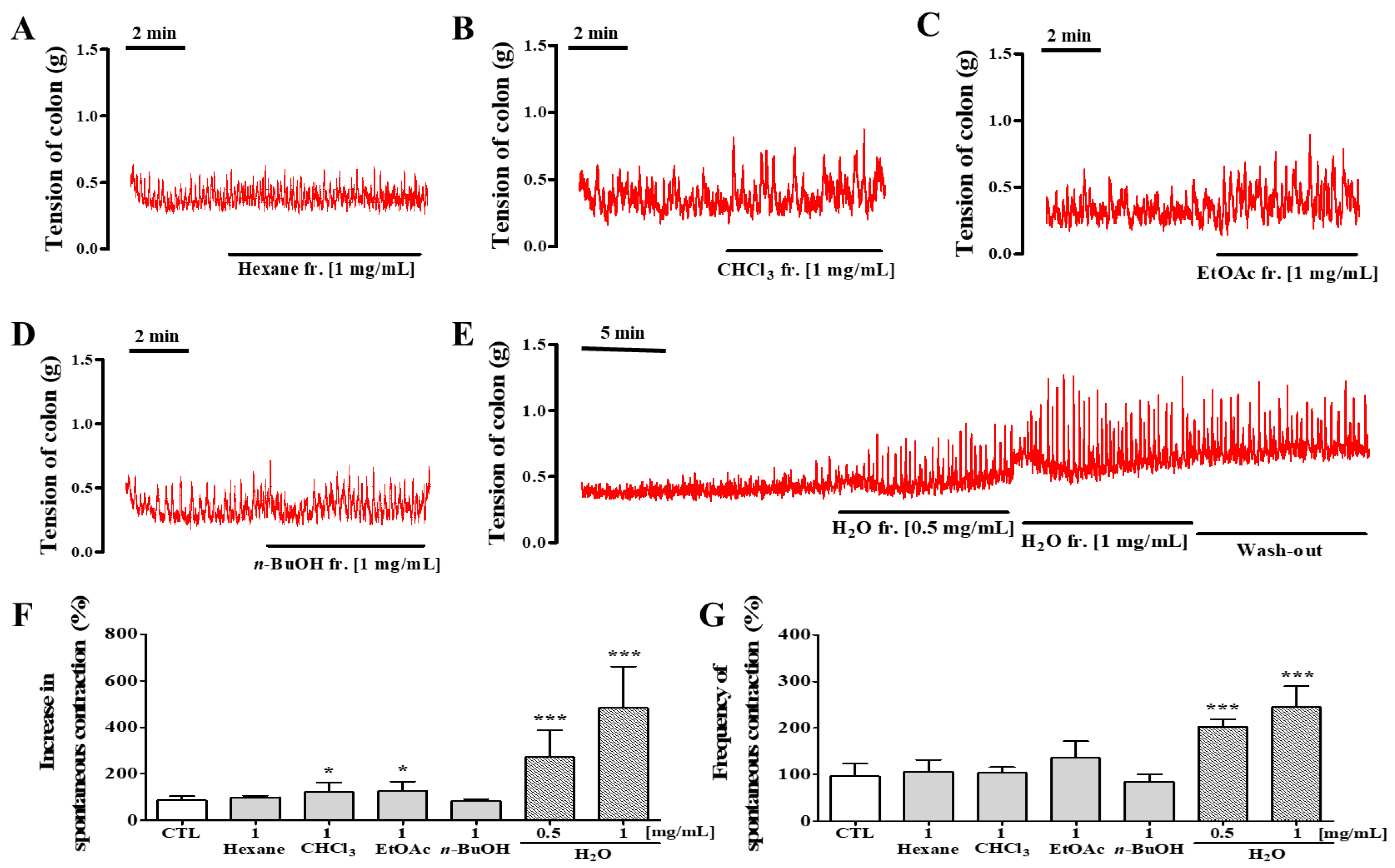
| Mean Number of Charcoal-Containing Stools/2 h (n = 7) | ||||||||||||
|---|---|---|---|---|---|---|---|---|---|---|---|---|
| Time (h) | 0–2 | 2–4 | 4–6 | 6–8 | 8–10 | 10–12 | 12–14 | 14–16 | 16–18 | 18–20 | 20–22 | 22–24 |
| CTL | - | - | 0.4 | 0.7 | 1.0 | 2.1 | 1.4 | 1.3 | 1.3 | 1.7 | 1.3 | - |
| Low fiber | - | - | - | - | - | 1.8 | 1.5 | 3 | 0.8 | 0.6 | 0.5 | 0.2 |
| DPL 50 | - | - | - | 0.3 | 1.0 | 1.2 | 0.8 | 2 | 0.8 | 1.2 | 0.5 | 0.2 |
| DPL 100 | - | - | - | 0.2 | 0.7 | 3 | 1.0 | 1.0 | 1.8 | 1.3 | 0.7 | 0.5 |
| DPL 200 | - | - | 0.3 | 0.3 | 1.2 | 2.5 | 0.8 | 2.2 | 1.0 | 1.5 | 1.3 | - |
| Mean Number of Charcoal-Containing Stools/2 h (n = 7) | ||||||||||||
|---|---|---|---|---|---|---|---|---|---|---|---|---|
| Time (h) | 0–2 | 2–4 | 4–6 | 6–8 | 8–10 | 10–12 | 12–14 | 14–16 | 16–18 | 18–20 | 20–22 | 22–24 |
| CTL | - | - | - | 0.5 | 0.8 | 2.7 | 2.8 | 2.5 | 1.5 | 0.8 | 1.3 | - |
| Low fiber | - | - | - | - | 0.8 | 2.3 | 1.3 | 3 | 0.5 | 0.3 | 0.3 | 0.5 |
| PCTL | - | - | - | 0.6 | 1.7 | 1.5 | 0.2 | 1.3 | 1.8 | 1.2 | 1.7 | 1.4 |
| DPL 50 | - | - | - | 0.2 | 1.8 | 1.6 | 1.4 | 1.4 | 1.2 | 2.8 | 0.8 | - |
| DPL 100 | - | - | - | 0.2 | 0.8 | 1.4 | 4.0 | 1.0 | 1.6 | 0.2 | 0.8 | 0.2 |
| DPL 200 | - | - | 0.4 | 0.6 | 2.6 | 0.4 | 3.8 | 1.6 | 2.4 | 1.8 | 0.8 | - |
| Mean Number of Charcoal-Containing Stools/2 h (n = 7) | ||||||||||||
|---|---|---|---|---|---|---|---|---|---|---|---|---|
| Time (h) | 0–2 | 2–4 | 4–6 | 6–8 | 8–10 | 10–12 | 12–14 | 14–16 | 16–18 | 18–20 | 20–22 | 22–24 |
| CTL | - | - | - | 1.4 | 1.2 | 2.6 | 2.4 | 1.6 | 1.6 | 1.0 | 0.6 | - |
| Loperamide | - | - | - | - | - | 0.1 | 1.3 | 2.0 | 1.6 | 1.5 | 0.5 | 1.5 |
| DPL 50 | - | - | - | - | 0.2 | 2.1 | 2.3 | 1.7 | 1.2 | 1.3 | 0.5 | 0.7 |
| DPL 100 | - | - | - | - | 1.2 | 2.7 | 2.0 | 1.8 | 1.5 | 1.0 | 0.8 | 0.5 |
| DPL 200 | - | - | - | 0.8 | 1.2 | 2.2 | 2.7 | 1.5 | 1.3 | 1.2 | 1.0 | - |
| Mean Number of Charcoal-Containing Stools/2 h (n = 7) | ||||||||||||
|---|---|---|---|---|---|---|---|---|---|---|---|---|
| Time (h) | 0–2 | 2–4 | 4–6 | 6–8 | 8–10 | 10–12 | 12–14 | 14–16 | 16–18 | 18–20 | 20–22 | 22–24 |
| CTL | - | - | - | 0.8 | 2.2 | 2.6 | 2.0 | 1.8 | 1.6 | 1.0 | 0.8 | - |
| Loperamide | - | - | - | - | - | 0.6 | 0.8 | 3.2 | 1.2 | 1.5 | 0.5 | 1.0 |
| PCTL | - | - | - | - | 0.2 | 1.4 | 2.2 | 1.8 | 1.2 | 1.2 | 1.0 | 0.2 |
| DPL 50 | - | - | - | - | - | 0.7 | 1.3 | 2.2 | 2.5 | 1.8 | 1.7 | 1.0 |
| DPL 100 | - | - | - | - | 0.3 | 1.7 | 2.3 | 2.8 | 2.3 | 1.4 | 0.7 | - |
| DPL 200 | - | - | - | 0.2 | 1.8 | 2.6 | 2.4 | 1.9 | 1.4 | 1.2 | 0.6 | - |
Publisher’s Note: MDPI stays neutral with regard to jurisdictional claims in published maps and institutional affiliations. |
© 2021 by the authors. Licensee MDPI, Basel, Switzerland. This article is an open access article distributed under the terms and conditions of the Creative Commons Attribution (CC BY) license (https://creativecommons.org/licenses/by/4.0/).
Share and Cite
Na, J.-R.; Lee, K.H.; Kim, E.; Hwang, K.; Na, C.-S.; Kim, S. Laxative Effects of a Standardized Extract of Dendropanax morbiferus H. Léveille Leaves on Experimental Constipation in Rats. Medicina 2021, 57, 1147. https://doi.org/10.3390/medicina57111147
Na J-R, Lee KH, Kim E, Hwang K, Na C-S, Kim S. Laxative Effects of a Standardized Extract of Dendropanax morbiferus H. Léveille Leaves on Experimental Constipation in Rats. Medicina. 2021; 57(11):1147. https://doi.org/10.3390/medicina57111147
Chicago/Turabian StyleNa, Ju-Ryun, Ki Hoon Lee, Eun Kim, Kwontack Hwang, Chang-Su Na, and Sunoh Kim. 2021. "Laxative Effects of a Standardized Extract of Dendropanax morbiferus H. Léveille Leaves on Experimental Constipation in Rats" Medicina 57, no. 11: 1147. https://doi.org/10.3390/medicina57111147






